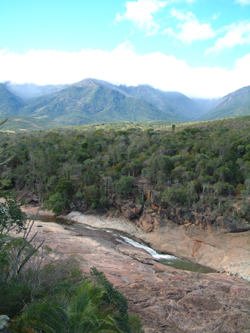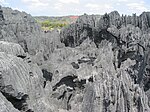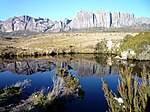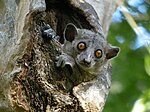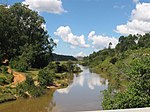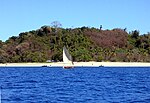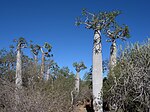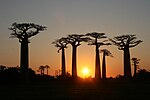
The Ministry of Ecological Transition, commonly just referred to as Ministry of Ecology, is a department of the Government of France. It is responsible for preparing and implementing the government's policy in the fields of sustainable development, climate, energy transition and biodiversity. Christophe Béchu was appointed Minister of Ecological Transition on 11 January 2024 under Prime Minister Gabriel Attal.
Manovo-Gounda St. Floris National Park is a national park and UNESCO World Heritage Site located in the Central African Republic prefecture Bamingui-Bangoran, near the Chad border. It was inscribed to the list of World Heritage Sites in 1988 as a result of the diversity of life present within it.

Masoala National Park, in northeast Madagascar, is the largest of the island's protected areas. Most of the park is situated in Sava Region and a part in Analanjirofo. Created in 1997, the park protects 2,300 square kilometres of rainforest and 100 square kilometres of marine parks. The Masoala Peninsula is exceptionally diverse due to its large size, and variety of habitats. Altogether, the park protects tropical rainforest, coastal forest, flooded forest, marsh, and mangrove. Three marine parks protect coral reefs and a dazzling array of marine life.

Makira Natural Park is a nature reserve in Madagascar's Northeastern region. In 2001, the Madagascar Ministry of Environment and Forests, in collaboration with the Wildlife Conservation Society (WCS), launched a program to create the 372,470 the Makira Forest Protected Area, with first temporary legal protections provided in 2005 as Makira Protected Area. Formally established as Makira Natural Park in 2012, the site is one of the largest of Madagascar’s protected areas and encompasses 372,470 hectares of strictly protected forest buffered by more than 350,000 hectares of community-managed forests. The Makira Natural Park is managed by WCS on behalf of the Government of Madagascar under a delegated management contract.
Andasibe-Mantadia National Park is a 155 square kilometre protected area, located about 150 km east of Antananarivo, consisting principally of primary growth forest in Alaotra-Mangoro Region in eastern Madagascar. The park's elevation ranges from 800 to 1260 meters, with a humid climate. Average annual precipitation is 1700 mm, with rainfall on 210 days of each year. This rainforest is habitat to a vast species biodiversity, including many endemic rare species and endangered species, including 11 lemur species. The park's two component parts are Mantadia National Park and Analamazoatra Reserve, which is best known for its population of Madagascar's largest lemur, the indri.

Atsimo-Atsinanana is a region in Madagascar. Its capital is Farafangana. The region used to be part of the Fianarantsoa Province.

Analanjirofo is a region in northeastern Madagascar. Until 2009 it was a part of Toamasina Province. It borders Sava Region to the north, Sofia Region to the west, Alaotra-Mangoro Region to the southwest and Atsinanana Region to the south.
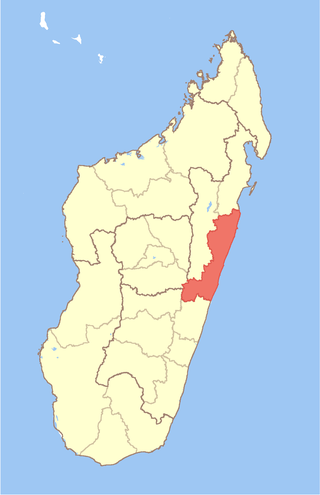
Atsinanana is a coastal region in eastern Madagascar. It borders Analanjirofo region in the north, Alaotra-Mangoro in the west, Vakinankaratra and Amoron'i Mania in the southwest, and Vatovavy in the south. The region contains over 285km of coastline, which includes many beaches and cultural heritage sites.

Tsimanampetsotsa National Park also spelt Tsimanampetsotse, and known as Tsimanampetsotsa Nature Reserve is a 432 km2 national park on the south-west coast of Madagascar in the region Atsimo-Andrefana. The park is 90 kilometres (56 mi) south of Toliara and 950 kilometres (590 mi) south of the capital, Antananarivo. Route Nationales (RN) 10 to Faux Cap passes the park and the nearest airport is at Toliara. The national park contains and is named after Lake Tsimanampetsotsa.

Zahamena National Park is a national park of Madagascar. Established in 1997, it covers an area of 423 square kilometres (163.32 sq mi) out of a total protected area of 643 square kilometres (248.26 sq mi). It is part of a UNESCO World Heritage Site, Rainforests of the Atsinanana, inscribed in 2007 and consisting of 13 specific areas located within eight national parks in the eastern part of Madagascar. In 2001, Bird Life International assessed avifauna of 112 species of which 67 species are exclusively endemic to Madagascar.

Zombitse-Vohibasia is a national park in the Atsimo-Andrefana region of south-west Madagascar. It is 147 kilometres (91 mi) north-east of the town of Toliara on the National road 7.
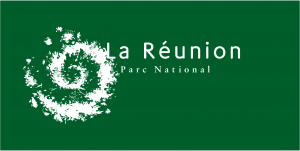
Réunion National Park is a National Park of France located on the island of Réunion, an overseas department in the western Indian Ocean. Established on 5 March 2007, the park protects the endemic ecosystems of Les Hauts, Réunion's mountainous interior, and covers around 42% of the island. Notable endemic species include the Réunion cuckooshrike and the Reunion Island day gecko.

Pointe-Taillon National Park(Parc national de la Pointe-Taillon) is a provincial park in Quebec, Canada. It is located on the north shore of Lac Saint-Jean, northwest of Saguenay (city), northwest of Alma, near the village of Saint-Henri-de-Taillon, on the banks of Lac Saint-Jean. The park covers an area of 97.5 km (60.58 mi) has as a 45 km (28 mi) cycling network.
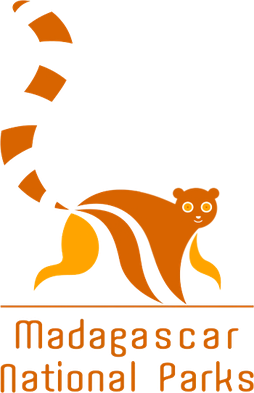
Madagascar National Parks, formerly known as the Association Nationale pour la Gestion des Aires Protégées, was founded in 1990 and is charged with managing a network of 46 National Parks, Special Reserves and Integral Nature Reserves in Madagascar. It is a private association that is legally recognised to have a public function since 4 December 1991, and it operates under the supervision of the ministry responsible for the environment, which, as of June 2008, is the Ministry of the Environment and Forests (MEF).
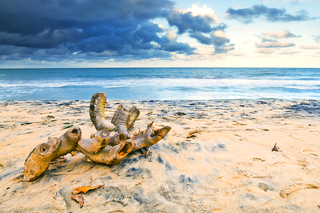
Mahanoro is a rural municipality located in the Atsinanana region of eastern Madagascar, along the coast.
Sena Oura National Park is a protected area with national park status in the African country of Chad. It was established in 2010 in the Mayo-Dallah Department of the western region of Mayo-Kebbi, on the border with Cameroon, created with the entry into force of Law 16 in an area of 735.2 km2. Form, together with the Bouba Ndjida National Park of Cameroon, a biosphere corridor. It is classified in Category II by IUCN. The administration of the park was entrusted to the authorities and representatives of the local tribes.
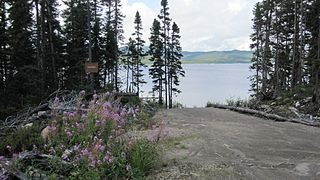
Lake Cacaoui is a lake in the Côte-Nord region of Quebec, Canada. It drains into the Sainte-Marguerite River.
